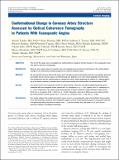Conformational Change in Coronary Artery Structure Assessed by Optical Coherence Tomography in Patients With Vasospastic Angina
Author(s)
Tanaka, Atsushi; Shimada, Kenei; Tearney, Guillermo J.; Kitabata, Hironori; Taguchi, Haruyuki; Fukuda, Shota; Kashiwagi, Manabu; Kubo, Takashi; Takarada, Shigeho; Hirata, Kumiko; Mizukoshi, Masato; Yoshikawa, Junichi; Bouma, Brett E.; Akasaka, Takashi; ... Show more Show less
DownloadTanaka-2011-Conformational Chang.pdf (1.394Mb)
PUBLISHER_POLICY
Publisher Policy
Article is made available in accordance with the publisher's policy and may be subject to US copyright law. Please refer to the publisher's site for terms of use.
Terms of use
Metadata
Show full item recordAbstract
Objectives:
The aim of this study was to investigate the conformational change of arterial structure in the vasospastic lesion with optical coherence tomography.
Background:
Coronary artery spasm plays an important role in the pathogenesis of ischemic heart diseases. The conformational change of each arterial layer during vasospasm has not been studied in detail.
Methods:
We assessed 19 coronary arteries (10 spasm and 9 nonspasm lesions) with optical coherence tomography during the provocation test for coronary spasm. An intimal bump was defined as 1 or more intimal projections into the lumen that disappeared after the administration of nitroglycerine (NTG). Intimal gathering was defined as a folding/gathering of the intima, resulting in multiple kinks in the luminal contour that resolved after the administration of NTG.
Results:
The spasm lesion more frequently showed an intimal bump at baseline and intimal gathering during spasm compared with the nonspasm lesion (spasm 80% vs. nonspasm 0%, p < 0.01, spasm 100% vs. nonspasm 0%, p < 0.01, respectively). The spasm lesion demonstrated a thicker maximum media thickness (spasm 0.24 ± 0.04 mm vs. nonspasm 0.12 ± 0.03 mm, p < 0.01) at baseline, whereas no differences were observed after the administration of NTG (spasm 0.13 ± 0.03 mm vs. nonspasm 0.13 ± 0.02 mm, p = 0.65).
Conclusions:
Our results suggest that medial contraction occurs even in an asymptomatic state and facilitates the formation of an intimal bump in patients with vasospastic angina. Luminal narrowing during spasm is associated with intimal gathering without alteration of intimal area.
Date issued
2011-10Department
Harvard University--MIT Division of Health Sciences and TechnologyJournal
Journal of the American College of Cardiology
Publisher
Elsevier B.V.
Citation
Tanaka, Atsushi, Kenei Shimada, Guillermo J. Tearney, Hironori Kitabata, Haruyuki Taguchi, Shota Fukuda, Manabu Kashiwagi, et al. “Conformational Change in Coronary Artery Structure Assessed by Optical Coherence Tomography in Patients With Vasospastic Angina.” Journal of the American College of Cardiology 58, no. 15 (October 2011): 1608–1613. © 2011 American College of Cardiology Foundation.
Version: Final published version
ISSN
07351097